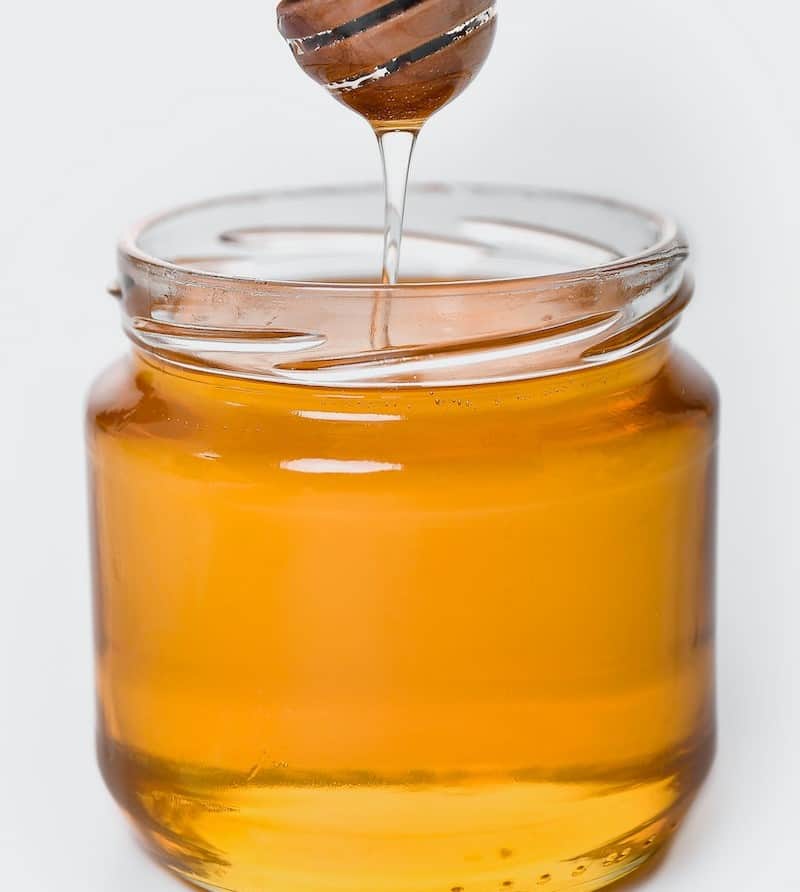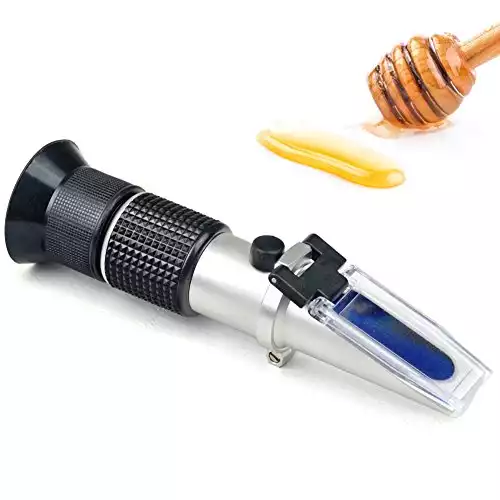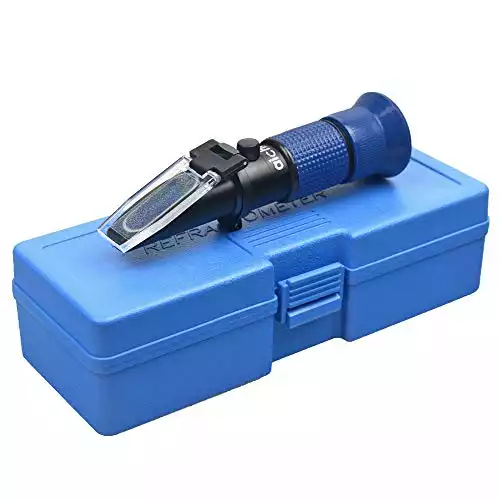When we talk about the quality of honey, two issues spring to mind:
- Adulteration
- Moisture level
Adulterated honey contains additives like corn syrup, either directly added to honey or fed to the bees and harvested as honey, which it is not.
In this article, we will focus on the second issue, moisture level. The moisture content of honey determines its shelf life.
Bees will wait until honey is sufficiently dehydrated before sealing it in the honeycomb with a protective layer of wax.
At that point, the moisture level is approximately 15-19%. With a moisture level measurement that low, the honey cannot ferment.
Unfortunately, some environmental factors can prevent the bees from capping the honey. If such is the case, you end up harvesting uncapped honey.
If nectar does not cure this situation, the moisture level remains high enough for yeast spores to flourish, which causes fermentation.
When you have extracted honey from both capped and uncapped frames, it is best to know the overall moisture content before you bottle or store it. That’s why you need a refractometer.
|
4.6
|
4.4
|
4.6
|
|
$22.88
|
N/A
|
$25.00
|
What is a Refractometer?
A refractometer is a gadget used to measure how light bends as it travels through a substance, in this case, honey, known as the refractive index measurement.
As light travels through different mediums, for example, air, water, or oil, it slows down depending on the density of the medium.
That is called light refraction or, simply, refraction.
Refractometers are used not only in the food industry and beverage industries. In the food and beverage industry, laboratory refractometers are used in measuring the refractive indices of wine, beer, and honey.
A refractive index measurement would also be useful in the production of coolants in the automotive industry.
In the gemstone industry, measuring prism through gemstones with the use of gemstone refractometers is critical in determining the quality of gems.
How a Refractometer Works
When testing food substances for quality control, such as honey, a refractometer is used as a measurement scale to detect the change in direction when light passes through the sample, indicating how many dissolved sugars are in the honey.
The result is given as a Brix refractive index and moisture percentage.
Since moisture is only 15-19% of the volume in honey, the dissolved sugars such as glucose and fructose and trace amounts of other elements will give a Brix percentage of over 80.
Refractometers are simple to use, as shown in the video below. In this video, a moisture level of 17% corresponds to a Brix percentage of 81.
The Brix percentage range varies in different Brix refractometers. Just like a weighing scale, it has a maximum or minimum weight limit.
Some refractometers are for various food products, while others are for specific purposes. For instance, one that is designed for honey is inappropriate for fruit juice or wine.
Before buying a refractometer, ensure the Brix percentage range incorporates honey Brix values.
We move on to the various types of refractometers available in the market.
Types of Refractometers
Analogue
The Analogue Refractometer is a common and affordable type of refractometer. It relies on an external source of light to give you a reading.
Once you have placed the sample on the prism and closed the cover, place the prism under a light, preferably a natural light source, for accurate data, and then look through the eyepiece.
You may need to adjust the eyepiece to get a clear measurement like you would a microscope. You should see a clear line between the blue area and the white area. That line will give you the Brix percentage and the moisture level.
Digital
Digital refractometers work the same way as analogue refractometers but use an LED light source. Once you have placed the sample on the screen, you flash the LED light, and the refractometer records the reading.
The data result is displayed digitally, so if your eyesight is giving you trouble, this is a better option than the analogue one.
No matter which of these two types you use, the refractometer’s accuracy depends heavily on calibration. That’s what we will talk about next.
How to Calibrate Your Refractometer
Although most refractometers are calibrated before shipment, it is best to verify by configuring them when you get them.
The liquid used to calibrate your refractometer depends on the kind of refractometer you have.
Sometimes, the calibration instructions tell you to use distilled water for a zero reading, yet your refraction readings range from 40-90% Brix. That’s because the seller can attach generic instructions unsuitable for the product you’ve bought, which is frustrating but fixable.
If your calibrated refractometers do not go as low as zero on Brix %, the recommended liquid is extra virgin olive oil, which has a Brix value of 71.5 or a corresponding moisture reading of 27%.
Ensure the prism is clean before configuring the gadget. Place only a few drops of oil or liquid on the prism. Adjust the screw until the line is at the 71.5 mark.
If you purchase a digital refractometer, the configuration instructions will be more specific and cater to your model.
What Affects Refractometer Readings?
Temperature
The scale used in the refractometers has 20°C written on it. That scale is accurate based on the temperature of the sample, which should be 20°C. The refractive index will change if the honey is hotter or colder.
Fortunately, these beekeeping gadgets now include an Automatic Temperature Compensation (ATC) function. The ATC works within a temperature range, but a sample on either extreme temperature would give wrong data or inaccurate results.
Cleanliness of the Prism
If the prism has a scratch or dust on it, that will affect the refraction reading of whatever sample you place on it. Use lint-free material to clean your refractometers after calibration and before use.
As mentioned earlier, give the prism time to dry thoroughly before placing your sample on it to ensure accuracy.
Application of the Sample
Too much or too little sample could cause an error in your reading. Spread the honey evenly across the surface of the prism.
Sampling from the Top or the Bottom
Honey is hygroscopic, meaning it absorbs moisture from the air. Its concentration may vary within the same bottle. The honey at the top of a container may have a higher moisture content than that at the bottom.
Mix the honey well before testing to ensure you get a homogenous sample.
What is a Refractometer Used for?

When You Are Extracting Honey from Uncapped Combs for Sale or Storage
If you keep bees as a hobby and are looking to save a few jars for yourself and your neighbors, you probably don’t need refractometers.
But if you have to store your honey for months at a time, a high moisture level could be disastrous and ruin your stock.
When You Want Award-Winning Honey
If you want to enter your honey in competitions, your honey moisture level should measure not more than 18.6%. Otherwise, it will be disqualified.
Which Refractometer Should You Buy?
Best Budget-Friendly
If you are looking for a multi-use, affordable refractometer, the Aichose model is a suitable choice. It is one of the best handheld refractometers.
The features include:
- 0-80% large-scale range, suitable for a variety of products, including jams and maple syrup
- Packaging is compact and portable
- This measuring tool is very easy to use and ideal for a beginner
- Chromium body makes it durable and hygienic to use
Best Analogue Refractometer
This model is the best choice for measuring the refraction index of honey. Although it has a narrower Brix percentage range, it has hundreds of positive reviews from happy customers. It is an analogue, portable refractometer that comes with a dropper, cleaning cloth, and screwdriver.
Other features include:
- Automatic Temperature Compensation (ATC) to ensure accurate readings at room temperature
- Made with Chromium for durability and hygiene
- Easy to use
Best Digital Refractometer
If you want to take human error out of refractometer index readings, you should try this digital refractometer. It will cost you a little more, but this one has a wide Brix scale, meaning you can use it for several types of food items.
Other features include:
- Built-in Automatic Temperature Compensation (ATC) (5-45°C) increases accuracy and gives you consistent and clear results
- Portable – it will fit in your pocket
- Waterproof and durable, passing the 1.5m dropping test
A Refractometer Is a Handy Gadget to Add to Your Kit
The weather may not always provide the right conditions to cure honey. In some parts of the country, beekeepers place uncapped frames in a room with a dehumidifier to reduce the moisture content before extraction. Others will mix low-moisture honey with high-moisture honey to give it a longer shelf life.
Wherever you keep your bees, these refractometers are useful tools to have with you.




